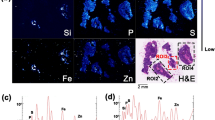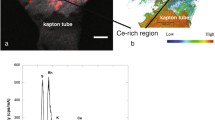Abstract.
The uptake of carcinogenic and mutagenic Cr compounds and the intracellular distribution of their biotransformation products in V79 Chinese hamster lung cells were studied by synchrotron-radiation-induced X-ray emission (SRIXE). SRIXE analysis was performed on whole cells that had been treated with either Cr(III) or Cr(V) 1,10-phenanthroline complexes, or Cr(VI). The high spatial resolution (0.3 µm) and elemental sensitivity (~10–15 g Cr/cell) of the technique provided detailed maps of Cr and other cellular elements in thin sections prepared from Cr(VI)-treated cells. The Cr carcinogen concentrated in P-rich regions corresponding to the nucleus, as well as other areas of the cell that are likely to correspond to organelles. This is the first study that has enabled the determination of the localization of the biotransformation products of Cr(VI) carcinogens in a target lung cell. Electronic supplementary material to this paper can be obtained by using the Springer Link server located at http://dx.doi.org/10.1007/s00775-002-0343-5.
Similar content being viewed by others
Author information
Authors and Affiliations
Additional information
Electronic Publication
Rights and permissions
About this article
Cite this article
Dillon, C.T., Lay, P.A., Kennedy, B.J. et al. Hard X-ray microprobe studies of chromium(VI)-treated V79 Chinese hamster lung cells: intracellular mapping of the biotransformation products of a chromium carcinogen. J Biol Inorg Chem 7, 640–645 (2002). https://doi.org/10.1007/s00775-002-0343-5
Received:
Accepted:
Published:
Issue Date:
DOI: https://doi.org/10.1007/s00775-002-0343-5




